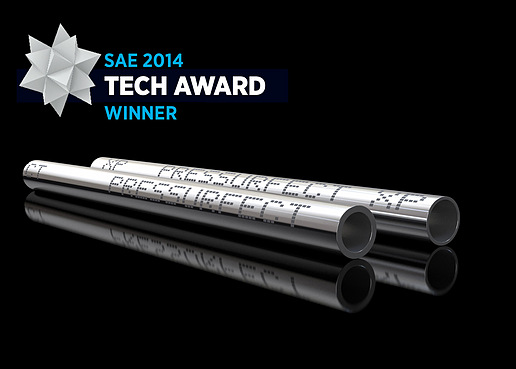 据山特维克称,Pressurfect XP无缝不锈钢管的一大优点就是它使得GDI系统在汽缸壁更薄的情况下保持相同的工作压力,从而减轻材料重量。
据山特维克称,Pressurfect XP无缝不锈钢管的一大优点就是它使得GDI系统在汽缸壁更薄的情况下保持相同的工作压力,从而减轻材料重量。
为了助力汽车行业寻找到更节油的技术,山特维克公司推出了两款无缝不锈钢管——Pressurfect和Pressurfect XP——来处理汽油缸内直喷(GDI)中的高燃料压力。
GDI系统可协助燃料喷射到压力相当高的气缸内,使得燃烧更均匀,更可控。供应商指出,燃烧室中不断升高的压力会对燃料管和燃料轨造成负担。另外,此类产品通常暴露于强腐蚀性的环境中,于是在使用不同的燃料混合物时情况会更为严重,例如混有乙醇的普通汽油。
为了应对这些挑战,山特维克开发了两种级别的定制钢材来生产燃料管和燃料轨,并称其在GDI系统中在“目前使用的和未来将使用的压力下”能够高度抗腐蚀并且展现出优秀的性能。
Jari Ponsiluoma是山特维克公司汽车部产品主管,他表示,碳钢管和焊接碳钢管耐腐蚀性较差,较易产生应力腐蚀裂痕。他认为高质量的不锈钢和双相(奥氏体-铁素体)不锈钢,如Pressurfect XP,将成为GDI技术和下一代燃料系统发展的关键推动者。
“基于高质量无缝不锈钢管的属性,Pressurfect能够在当今的GDI系统中以较高的安全系数来应对燃料压力”,Ponsiluoma通过电子邮件向SAE杂志解释道,“更重要的是,它非常适合用于解决下一代GDI系统压力升高这一问题,因为高压会给标准焊接或其他质量等级更低的不锈钢管造成负担。”
Ponsiluoma还表示,由于Pressurfect XP的材料成分,山特维克能够提供更低的全寿命周期成本:“使用这种材料,发动机设计师现在就已经能够设计出更高效的GDI系统,来适应未来更严格的法律规定了。一大主要优点是我们可以使GDI系统在相同的工作压力下使用更薄的壁厚,从而减小管材/组件的重量,而这将为我们的客户提供成本效益。”
管材壁厚为0.89 到3.0毫米(0.035到0.118英寸),公差为±10%。在20摄氏度(68华氏度)时,Pressurfect的保证强度≥210兆帕,抗张强度为515到680兆帕,而Pressurfect XP的保证强度≥450兆帕,抗张强度为690到820兆帕。
这两种新产品同样具有良好的可加工性。山特维克的报告中说他们已经收到了客户关于Pressurfect可加工性和钎焊属性的正面反馈。
“尽管我们对这两种级别的产品本身并不陌生,但GDI系统的厂商对表面性能等参数有非常具体的要求”,Ponsiluoma说,“我们付出了巨大的努力来满足这些特定的行业要求,并保证各个批次的质量高度一致,并具有可追踪性。”
燃料轨的材料是经过挤压、冷轧、固溶退火的无缝钢管;燃料管的材料是经过挤压、冷轧、冷拔、固溶退火的无缝钢管。
Ponsiluoma指出,山特维克公司的汽车部正在与研发部和多个客户合作,测试这两种产品在除了下一代GDI系统之外的其他领域未来应用的可能性。
To assist the automotive industry in its quest to develop ever more fuel-efficient technologies, Sandvik Materials Technology is launching two grades of seamless stainless tubing—Pressurfect and Pressurfect XP—to handle higher fuel pressures in gasoline direct injection (GDI) engines.
GDI systems facilitate the injection of fuel into the cylinders at considerably higher pressures, resulting in a more controlled and even burn. Rising fuel pressure in the combustion chamber is placing strains on fuel lines and fuel rails, the supplier notes. In addition, such products are often exposed to a highly corrosive environment, which can be exacerbated by the increasing use of different fuel blends, for example ethanol in regular petrol.
To counter these challenges, Sandvik has developed two tailored steel grades for fuel line and fuel rail production that it claims are highly corrosion resistant and perform well with “the pressures being used today and for the foreseeable future” in GDI systems.
Carbon steel tubing and welded carbon steel tubing exhibit less resistance to corrosion and stress corrosion cracking, according to Jari Ponsiluoma, Product Manager Automotive, Sandvik Material Technology. He believes high-quality stainless steel and duplex (austenitic-ferritic) stainless steel—i.e., Pressurfect XP—will become key enablers in the evolution of GDI technology and next-generation fuel systems.
“Due to the properties of high-quality seamless steel tubing, Pressurfect is capable of handling fuel pressures in today’s GDI systems with a healthy safety margin,” Ponsiluoma explained to SAE Magazines via email. “More importantly, however, it is ideal for coping with the rising pressures in the future generations of GDI systems, which are putting a strain on standard welded or other inferior-quality grades of stainless tubing.”
Due to the material composition of Pressurfect XP, Sandvik can offer lower total life-cycle cost, according to Ponsiluoma. “With this material, the engine designer can already now design more-efficient GDI systems to meet the tougher future legislations. One of the main benefits is that we can offer thinner wall thickness using the same working pressure in the GDI systems. This will give our customers a cost benefit due to lower weight on the tube/component.”
Wall thickness for the tubing ranges from 0.89 to 3.0 mm (0.035 to 0.118 in), with a tolerance of ±10%. At 20°C (68°F), Pressurfect has a proof strength of ≥210 MPa and tensile strength of 515 to 680 MPa, while Pressurfect XP’s proof strength is ≥450 MPa and its tensile strength 690 to 820 MPa.
The new grades are also highly machinable. Sandvik reports that it has received positive customer feedback on Pressurfect’s machinability and brazing properties.
“While the grades themselves are not new, the makers of GDI systems have very specific requirements when it comes to surface properties and other parameters,” Ponsiluoma shared. “Extensive efforts have been made to meet these specific industry requirements and to prove consistent quality and traceability for all batches.”
The material for the fuel rails is extruded, cold pilgered, and solution annealed seamless tubes. The fuel lines are extruded, cold pilgered, cold drawn, and solution annealed seamless tubes.
Ponsiluoma noted that Sandvik’s Automotive group is working with the R&D department and various customers to test the two new products for other future application areas beyond next-generation GDI systems.
等级
打分
- 2分
- 4分
- 6分
- 8分
- 10分
平均分
